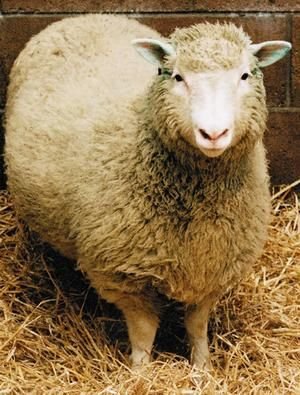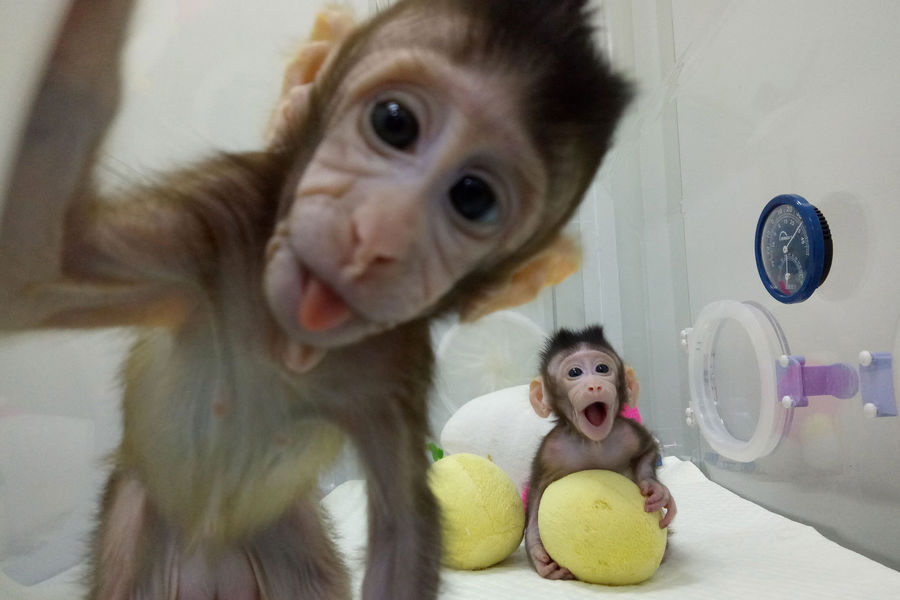First cloned primates 🐒🐒
First cloned primates
After Dolly, the first cloned sheep, scientists have cloned small monkeys. I saw a report yesterday on television about it, it's amazing, is not it?
This is very good news for medicine, although being against the free abuse of animals, I find that to advance medicine is a good thing although to see animals unhappy in cages do not please me not if it can save children or parents then in this case, it's still a wonderful service they give us.
I am sensitive about medical research since I had a skin cancer at age 30 a few years ago while my second son was only 6 months old and I have a big risk to catch breast cancer because there is a lot of history in my family ...
On the other hand for all that is test on the animals for make-ups and others, I am completely against obviously because this kind of experiments is not vital.

Cloning
Chinese researchers have for the first time cloned primates using the techniques that made it possible to create the Dolly sheep more than twenty years ago.
The originality of this new method lies in the use of epigenetic modifiers used to reprogram the gene pool of the donor cell. This modifier, which is an enzyme, is therefore used to make a kind of epigenetic reset of the cell, which erases the marks related to differentiation.
This scientific breakthrough could help stimulate medical research.
The cloned little monkeys are called Zhong Zhong and Hua Hua. Their names are derived from the Chinese adjective Zhonghua meaning the nation or the Chinese people. They carry the same genetic heritage, like homozygous twins, while they were born with a few weeks apart in a laboratory at the Institute of Neuroscience of the Chinese Academy of Sciences in Shanghai.
These are the first primates to be cloned through a variation of the method used for the birth of the Dolly sheep in Scotland in 1996.
At the time, it was the first mammal cloned from an adult cell taken from the udders of an ewe.
Since then, about 20 other mammal species, such as dogs, cats and pigs have been cloned, but primates have proved particularly difficult to clone.

Medical hope
According to scientists, populations of genetically identical monkeys will be useful for research on human diseases. This would allow, for example, to be able to observe the impact, on one of these monkeys, of the modification of a gene linked to human pathologies and to compare its state of health with macaques with the same genetic inheritance before the alteration of the gene. in question.
The idea is to accelerate the identification of genes and genetic processes that cause genetic diseases to better address them.
Chinese researchers want to develop animal models all identical, close to humans, to test treatments against neurodegenerative genetic diseases.
The problem is that this cloning entails a certain cost since it takes a lot of tests before it ends, indeed, for the two small monkeys for example, according to statistics, it took 417 oocytes, including 109 embryos created from fetal cells and 190 from adult cells. Only 28 pregnancies were obtained, 4 have come to term and only two macaque babies are viable. The chance of success is between 1% and 2% of trials, for the only method that works and that scientists know for the moment.
So it is not yet tomorrow that we can cure diseases by studying clones.

Ethics
There is a difference between the cloning of sheep, pigs or dogs and that of a primate. Indeed, primates being closer to humans, primate trials in the West must pass a thorough ethical review, without which approval can not be obtained.
Some worry that after the primates, the men will be the next mammals was cloned for medical purposes but that could lead to drifts.
Scientists reassure that they will not extend this cloning technique to humans ...
Excellent for science, but what is it scary to see that ... It's not a novelty certainly, but it's a step higher, again and again ...
First let me say very sorry for having skin cancer at the age of 30. Interestingly, with the rapid advancement in medical research especially on cloning and stem cell, we hope the future will be bright. Thanks for sharing such information on cloning.
Thank you 😊
earlier we could only dream about cloning. This was a fantasy that was often shown in movies or scientific journals. Now with the development of science and advanced technology, we are witnessing what was previously impossible. And one such achievement is cloning.
Indeed, there are many opposing opinions on this matter. One such morality is in such experiments. Many people do not like the fact that animals suffer in such experiments, and yes .. I think this is a minus.
But if we look at the opportunities that cloning provides in the future, we can not deny the benefits.
I also like the recent experiment when scientists managed to grow fully artificial meat, which by taste qualities resembles meat of animal. I think the future will surprise us.
Thanks @lndesta120282 for the interesting article
you know that i am a medical student so science is interesting subject for me and you sharing a valuable post about post...so i like your post again... thanks for sharing this good thinking post...
OMG!! I did not think it was possible
Now the only thing that can stop human cloning is government regulation. Will that be enough? ...There probably are already cloned humans in existence, created on the DL.
wow , amazing monkey . i like it . great sharing @lndesta120282
I hope this will mean a further progress to stop some serious desises like cancer or AIDS, keep up scientists 😀😀
Interesting work. I wonder if these cloned monkeys will live a normal life span as Telomere length models of aging predict that the nuclear-transfer-derived animal would reach a critical telomere length sooner than a non cloned animals.
The results of this cloning look funny. They are really funny. But, whether the conclusions of this invention will be applied to humans?